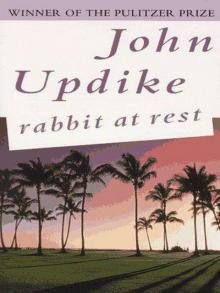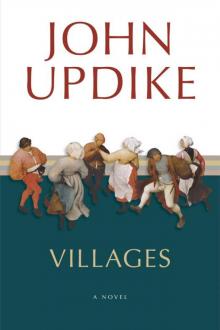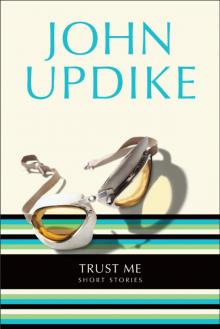- Home
- John Updike
Odd Jobs: Essays and Criticism Page 2
Odd Jobs: Essays and Criticism Read online
Page 2
Though it is hard to believe that even that chairbound agoraphobe will read this collection straight through, I have tried to arrange its over one hundred and sixty items along an encouraging curve. The book arches from the fairly personal into the wide heavens of other people’s books and then back to the grassy earth of the personal again, in the form of salvaged bits of autobiography and autocriticism. It became my habit to review, for The New Yorker, two or more books together, aggregation providing a pleasant reinforcing effect. Where the pairing was but lightly secured, I have separated the titles, but in most cases the glue of joint argumentation resisted, and the bond was allowed to stand. Hence only one author, Philip Roth, has a section all to himself, and some, like Umberto Eco and Mario Vargas Llosa and Robert Pinget, are repeatedly considered but in widely separated places. Where a miniature review, written anonymously for The New Yorker’s “Briefly Noted” section, fit handily, I slipped it in. Laughably loose categories like “Other Countries Heard From” and “Odd Couples” catch the otherwise unclassifiable. Most of the books reviewed are novels and most of these, by my preference, are from across the Atlantic or south of the border. The innovative power of American realism isn’t what it was for Hemingway and Faulkner, and foreign solutions to the puzzle that fiction poses in this post-print, anti-teleological era held out to me hope of some magical formulae that wouldn’t occur to my fellow countrymen.
The reviews are undated but were generally written the years the books were published, which are given in the subheadings. An effort has been made to reproduce the numerous quotations accurately, even to paragraph indentations and English spellings. Franklin, Emerson, and Howells are as they appear in the Library of America texts, quaint punctuation and all. The problem of how to address authors in the course of a piece, where their names arise as faithfully as a drumbeat, has been relegated to the inconsistencies of social instinct: simple last names sit less rudely on men than on women; in the case of a female author known to use a married name, “Mrs.” is used, and “Miss” for maiden-name users old enough not to find the usage curious. Mrs. Spark, Miss Murdoch, Ms. Tyler: please don’t be offended. But for a few brief footnotes, no attempt has been made to bring the historical background—the contemporary temperature of the Cold War, the political condition of Chile and Germany and Albania—up to date. Most of the pieces belong to an already slightly bygone era when Ronald Reagan reigned over the United States and William Shawn over The New Yorker, and it seemed important to quote from Calvino and Borges at length. The presiding term was “postmodern,” yet, though the concept of postmodernism comes in for a grapple several times, I remain uncertain whether it means anything more than a bored playfulness and a nagging sensation of déjà vu. It is perhaps in the nature of Nineties to be mauve decades, silted-up fins de siècles. These assembled critical considerations muster, it seems, their stoutest enthusiasm for the products of decades early in the century, when even Kafka’s terrible vision had an edge of naïveté to it, an awareness undulled by an accumulated and still-accumulating muchness. My diffident title for this high heap of work is, I suppose, postmodern in itself. But honest labelling never goes out of date, and an honest laborer usually gets his due.
J.U.
September 1990
Fairly Personal
FIVE DAYS IN FINLAND AT THE AGE OF FIFTY-FIVE
AS I GET OLDER, my childhood self becomes more accessible to me, but selectively, in images as stylized and suspect as moments remembered from a novel read years ago. In one of my first memories, I am lying on the floor reading newspaper headlines to my grandfather, who has been temporarily blinded by a cataract operation, and the cartoon on the editorial page shows a little fellow on skis defiantly standing up to a huge bear, who is wearing bandages and has the cartoon symbols signifying dizziness and pain scattered about his head. The bear is Russia, and this must be the Russo-Finnish “Winter War” of 1939–40, when I am seven. At some later moment in my childhood, I am pondering a photograph of Jean Sibelius, perhaps in Life. His head is spectacularly bald, whereas all the other composers I have seen depicted are very hairy. His eyes are shut, as if he were intently listening or having a headache, perhaps from the veins that stand out on his bald head. He lives in Finland, the caption tells me, among lakes and forests. Finland: a cold, shaggy place, far away. To me at that age the world is like a coloring book, full of outlined spaces. When one visits such a space, that colors it in.
Although, by the age of fifty-five, I had been to Norway, Sweden, Denmark, and, on the far side of Scandinavia, the Soviet Union, I had never been to Finland. All I had added to my images of Sibelius and Finnish valor were yards of splashy Marimekko fabric, with which my first wife had draped our windows and herself. Then an opportunity arose: I was asked to come to Sweden, for a conference, and agreed if I could also spend five days in Finland, for fun. People seemed amused. Finland? A number of my professional acquaintances had attended conferences in Helsinki, much as they had in Tokyo, Aspen, and Atlantic City. Helsinki to them was a set of hotel rooms, a city without qualities.
But I take an interest in hotel rooms. To the man travelling alone, his hotel room, first entered in rumpled clothes, with a head light from sleeplessness, looms as the arena where he will suffer insomnia, constipation, loneliness, nightmares, and telephone calls; his room will become woven into the deeper, less comfortable self that travel uncovers. My room in Helsinki was shaped like a triangle with a tip cut off, and in the truncated corner was fitted a long wooden tray that would be my bed. Pieces of upright varnished wood were spaced about on the walls, notched as if for some utilitarian purpose but revealing to inspection no other purpose than to look Finnish. Wood, it seemed, was the Finnish look—wood, and a certain determined stylishness of design. The closet coat hangers were especially progressive—abstract sculptures of white plastic it took some practice to manipulate. One’s hotel room is a place one is always trying to leave and yet always returning to. Staying in it, alone with the television set, seems cowardly and a waste of the airplane ticket, and yet leaving it—stepping into the long, windowless, carpeted hall, letting the door click shut as you tap your pocket to make sure the key is there—has a sadness, too, the sadness of rejecting a symbolic mother, a place that would serve as home.
It was raining when I arrived in Finland, in mid-August of what people told me had been the coldest and rainiest summer in a hundred years. I set out from the hotel room to walk around Helsinki, but the rain defeated me. I found a handsome esplanade, of unoccupied benches and tightly shut kiosks, but there was no place, at six o’clock on a Saturday evening, where I could buy an umbrella. In an American city, some capacious all-night drugstore would have had a basket of umbrellas tucked away over in a corner by the discounted bathing caps and welcome mats, or some boutique would have hungrily kept open an extra hour to catch the stray tourist, but here a grave mercantile decorum had shut up everything except for a bright-yellow hamburgerrestaurant called Clock. The Finns had umbrellas, most of them, and some even wore boots—ankle-high wading boots with pale soles—but others, the younger ones, walked along as if the rain were all in my mind. I ducked from doorway to doorway along the esplanade until I arrived at a harbor where a towering white ferryboat was slowly turning its stern upon the city and heading out through a misty maze of islands. Destinations that are not ours always seem romantic. I was in Finland, but sitting on it like a raindrop that, unlike the drops on my scalp and raincoat, had not begun to soak in.
Next day, a Sunday, I took a train to Savonlinna, the heart of the region of lakes and forests. In the railroad station (designed by Eliel Saarinen), a brilliant arcade of food shops contrasted with the abandoned gloom of most American terminals, and I attempted to start soaking into Finland by making a purchase. In a candy store I spotted a bag of what in England are called “licorice all-sorts.” I read on the label ENGLANNIN LAKRITSI; these words seemed within my capacity to pronounce but the woman at the counter stared at me with alarmed
incomprehension, and even my pointing gestures took her some time to decipher. She counted out my change for me in a mincing, rebuking English. The Finnish language, a non-Indo-European tongue related to Hungarian and Estonian and a number of minor variants like Karelian, Olonets, Lude, Vepse, and Vote, yields few clues to an American. As a focus of Finnish nationalism through centuries of domination by Sweden and, after 1809, Russia, it resists loan-words, though APTEEKKI identifies an apothecary, POSTI a post office, POLIISI the police, and ESPLANADI and MOOTORI what you might imagine. POSTIPANKKI is a postal bank, but PÄIVÄRANNAN RUUSU is the name of a flower shop and not a Russian restaurant. During the six-hour train ride to Savonlinna, I kept seeing on other railway cars AIDS ON TAPPAVA TULIAINEN: I thought the first word could not be what it seemed but it turns out that indeed the Finns have borrowed the English acronym and were publicizing a campaign against the disease. There is a certain bliss in being surrounded by a language that no one expects you to know. Nevertheless, it annoyed and even frightened me that for five days I was unable to recall so much as the word for “thank you,” which is kiitos. The double “i” would come to mind but the consonants kept scrambling.
Through the train windows, the Helsinki suburbs fell away, and lakes and forests began. Relatively few species dominated—pine (Pinus sylvestris, Scotch pine, the trunk pinkish, as if rubbed raw, above the lower portion), spruce, and white birch—with here and there silvery willows, twinkling aspens, rowan trees decked out in their bright-orange berries, and alders clogging the drainage ditches. The fields, irregular in shape, were all drained by ditches, and the stands of rye and wheat were flattened in ragged patches, as if by rambling dogfights. It seemed a restless, struggling agriculture: some fields were being reclaimed by the forest, and others had been recently cleared, with heaps of stumps left to dry and blanch in grisly bone-colored tangles. Muddy cabbage-patches near the tracks flicked past, and towns hurriedly assembled and dispersed. The traditional wooden architecture mingled vertical and horizontal boards in a way that looked faintly barbaric, like the hatching in a Steinberg drawing; the older houses showed a complex abundance of gables and dormers. These domestic fortresses, whose prominent double-casement windows bespoke winter’s long siege, were roofed mostly with ridged tin, and sometimes with tile, rather than with the battened planks of earlier centuries. A picture-book farm whose manse and outbuildings bore matching red sides and minty-green roofs—Christmas colors—made me realize how few of these habitations could be called pretty. Like the Finns themselves, they seemed more sturdy than ornamental.
The landscape, with its rubbed-looking pines and low granite outcroppings, didn’t much vary. Monotonous landscapes, perhaps, are the most penetrating, and inspire the most intense nostalgia: we love countries that dare to bore us. As the train looped north, it passed, I could see by the map, very close to the Russian border, but I failed to spot, above the bristling tree-line, the watchtowers I was told were there. Lakes opened up the vista on one side of the tracks or the other and then on both sides as we rolled along the famous, photogenic Punkaharju ridge—Finland’s postcard icon, its Mount Rushmore, its Eiffel Tower. The morning’s windy bits of blue sky had disappeared and it was raining again, and the lake water looked black and bitter, slapping the embankment with little dirty waves. I still had no umbrella.
Savonlinna itself, where I found my hotel by crossing a narrow bridge in a drenching rain, had the wistful melancholy of a summer place out of season—empty balconies and outdoor tables, deserted docks and diving boards, boats moored in waterlogged rows. European vacation places always seem a bit slick and tinny to me, perhaps because they awaken no memories of my own childhood holidays. Yet, after eliciting tea from a waitress in the bar and letting my raincoat dry for an hour, I borrowed an umbrella at the hotel desk and set out to see what wet sights there were. It reminded me of, years ago, my venturing up Wilshire Boulevard, in another Sunday twilight, to fulfill a lifelong ambition to view the La Brea Tar Pits. On the old Jack Benny program, they used to crack jokes about the tar pits, and though I was in Los Angeles for only a night, and had a worrisome toothache, I had waited much of my life for this opportunity. Oddly, though I could only peek through a fence, and a tar pit in the dark is not much to see, I was not disappointed. A sight is composed, in large part, of our desire to see it. And, as we say on a golf course when it rains, “At least it’s kept the crowds away.” Savolinna was not crowded.
Cozy and dizzy with jet lag beneath my borrowed umbrella, I walked along the lakeside, under dripping linden trees, past pastel holiday homes and shop windows hopefully displaying images of bronzed beauties. A beach that had, in the tourist brochure I had studied, extensively brimmed with basking flesh seemed in reality no bigger than a hall rug, set out to soak. Olavinlinna Castle, approached across a little bridge where my umbrella nearly blew inside out, was closed. The floating walk to it was rather gleefully tied up on the other side of a kind of moat, and a trio of German hikers clowned away their disappointment in the small green park here, like sparrows frisking in a birdbath. But the civic museum nearby, quite surprisingly, was open. Just as a toothache almost justifies itself in the relief of its ceasing, our trips to Europe pay off with these unexpected admissions.
Inside, it was dry, and dim, and almost deserted. On the first floor, primitive Finland explained itself in terms of geological maps, Neolithic artifacts, rock paintings executed at heights that indicated shifting lake levels, agricultural tools of a touching cleverness and gawky beauty, a reconstructed peasant’s house with one dummy in a rocking chair and another tucked asleep up in a high nook against the whitewashed fireplace chimney. Finland’s land, I read, had emerged from the sea less than twenty thousand years ago, and was still rising, a centimeter a year. On the museum’s second floor, a new exhibit revelled in the ingenuity with which the nation’s proud and perennial harvest of trees was conducted: logs used to herd logs, logs lashed into chutes and bumpers and, when wide lakes were reached in the logs’ watery descent toward the sawmill, into great floating corrals pulled to the next river by oared or steam-driven boats. The chains of logs had been tied together with knotted withies, and snow as well as water had been employed to skid the trees out. The tools of this epic labor, the axes and grapples and the marking sledges that branded the logs like heads of cattle, the antique measuring calipers and early chain saws and the long files that restored metal’s virginal edge composed that solidest type of poetry, the shapes of fact and necessity. The poetry sang without words to me, for the only words in English were DON’T TOUCH THE OBJECTS, PLEASE, a command which in Finnish was even more forbidding: NÄYTTELYESINEISIIN KOSKEMINEN KIELLETTY!
As if worn out with all this vicarious logging labor, I fell asleep easily after dinner in the hotel; but I awoke at two, and stayed awake until six, when it would have been eleven at night at home. The bone-deep self-estrangement of jet lag: is it for this racking existential confrontation that we travel? In the wrestle with insomnia, my heart felt stuffed with tremulous agitation, and my head seemed a bundle of electricity irrepressibly twitching my body. All the people of my life, from my eighty-three-year-old mother to my three-month-old grandson, passed through my consciousness in a murky, nebulous cloud of unfulfilled responsibility. Dread crystallized as a strange, periodic, unlocated clicking from the direction of the bathroom. The hotel room was paler and more modern than the one I had left in Helsinki and to which I would return; but the bed also suggested a tray—a tray on which I was being offered to Morpheus, who turned up his nose.
In the vain effort to escape myself, I shifted my pillow and my head to the bed’s other end, and, that failing, I stepped onto the balcony and gazed at the sleeping resort city. The names of hotels and stores were spelled in light, but nothing moved. Not even the clouds moved—yellowish strips of nimbus that seemed the hellish underside of something else. I had never before been—not in Leningrad, not in the Orkney Islands—this far north on the planet, and the arrangement of reservat
ions and obligations whereby I would make my way home seemed impossibly rickety and precarious. The precariousness of being alive and human was no longer hidden from me by familiar surroundings and the rhythm of habit. I was fifty-five, ignorant, dying, and filling this bit of Finland with the smell of my stale sweat and insomniac fury.
But in the morning, a Monday morning, the stores were open, and it was so blowy and cold the people in the market were wearing gloves and wool caps. For twenty finnmarks—a bargain, less than five dollars—I bought an umbrella from a girl in a market stall. “Cold,” I said. She laughed: “Very cold!” The joys of exchange. Because it was so comically cold, I bought a hat and some candy along a main street of stores that reminded me of one in a busy English tourist town, like Windsor—especially the sweetshop down a few steps off the street, with candies and nuts loose in jars, and a bored girl weighing the purchases on a computerized scale. At times, as when I had watched on television an earnest Algerian documentary about nation-building, or observed the elderly, slightly shabby Finns around me in the hotel, I had felt I was in a Socialist country—a relatively liberated one, like Yugoslavia—but Monday morning banished any doubt that consumerism reigned in Finland. The department store, in its layout and contents, spelled out an intelligible code, even to the word KASSA for cashier; the language of buying and selling, of displays and price tickets and receipts and correct change, was one I could speak, though I couldn’t manage to say “kiitos.” At an APTEEKKI, I bought a little round, drum-shaped box of Oropax, those fuzzy wax earplugs available only in Europe. They seemed smaller than the Oropax you get in Italy—there was less noise, possibly—and cost only twelve finnmarks. On second thought I went back into the drugstore and bought another box. Our attitude to spending foreign currency goes through two stages: at first, one is reluctant to part with it, as if its uncertain value makes it immeasurably precious; then one begins to spend quite freely, as if it is play money, and one is playing a trick by getting real goods for it.

 Picked-Up Pieces: Essays
Picked-Up Pieces: Essays Bech: A Book
Bech: A Book Roger's Version: A Novel
Roger's Version: A Novel Seek My Face
Seek My Face The Carpentered Hen
The Carpentered Hen Pigeon Feathers: And Other Stories
Pigeon Feathers: And Other Stories Rabbit Is Rich
Rabbit Is Rich The Afterlife: And Other Stories
The Afterlife: And Other Stories Rabbit at Rest
Rabbit at Rest The Witches of Eastwick
The Witches of Eastwick Gertrude and Claudius
Gertrude and Claudius Bech Is Back
Bech Is Back Hub Fans Bid Kid Adieu: John Updike on Ted Williams
Hub Fans Bid Kid Adieu: John Updike on Ted Williams Marry Me: A Romance
Marry Me: A Romance Museums and Women: And Other Stories
Museums and Women: And Other Stories My Father's Tears and Other Stories
My Father's Tears and Other Stories Collected Poems, 1953-1993
Collected Poems, 1953-1993 Trust Me: Short Stories
Trust Me: Short Stories Odd Jobs: Essays and Criticism
Odd Jobs: Essays and Criticism Rich in Russia
Rich in Russia Higher Gossip: Essays and Criticism
Higher Gossip: Essays and Criticism The Widows of Eastwick
The Widows of Eastwick In the Beauty of the Lilies
In the Beauty of the Lilies Rabbit, Run
Rabbit, Run The Early Stories: 1953-1975
The Early Stories: 1953-1975 Rabbit Redux
Rabbit Redux S.
S. Brazil
Brazil Toward the End of Time
Toward the End of Time The Centaur: A Novel
The Centaur: A Novel Assorted Prose
Assorted Prose Memories of the Ford Administration
Memories of the Ford Administration Terrorist
Terrorist Couples: A Novel
Couples: A Novel Bech at Bay
Bech at Bay The Music School: Short Stories
The Music School: Short Stories Villages
Villages S
S Roger's Version
Roger's Version Pigeon Feathers
Pigeon Feathers Higher Gossip
Higher Gossip Rabbit Redux r-2
Rabbit Redux r-2 Memories of the Ford Administration: A Novel
Memories of the Ford Administration: A Novel The Centaur
The Centaur Marry Me
Marry Me Picked-Up Pieces
Picked-Up Pieces Bech
Bech Rabbit Remembered
Rabbit Remembered Trust Me
Trust Me The Early Stories
The Early Stories Odd Jobs
Odd Jobs The Centaurus
The Centaurus The Afterlife
The Afterlife The Music School
The Music School Museums and Women
Museums and Women Couples
Couples